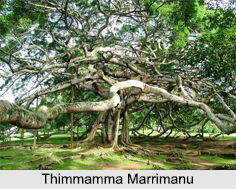 Thimmamma Marrimanu is the name of a Banyan tree which has religious significance. In Telugu language, the terms "Marri" and "Manu" means banyan and tree respectively. It has branches spread over 5 acres with a canopy of 19,107 square metres. It has 1100 prop roots. The banyan grows from the top down. Seeds in the tree"s branches allow a tendril to drop to the ground, expanding the banyan"s reach. These 1,100 prop roots are what makes the singular tree appear to be an entire forest.
Thimmamma Marrimanu is the name of a Banyan tree which has religious significance. In Telugu language, the terms "Marri" and "Manu" means banyan and tree respectively. It has branches spread over 5 acres with a canopy of 19,107 square metres. It has 1100 prop roots. The banyan grows from the top down. Seeds in the tree"s branches allow a tendril to drop to the ground, expanding the banyan"s reach. These 1,100 prop roots are what makes the singular tree appear to be an entire forest.
Thimmamma Marrimanu is recorded as the biggest tree in the Guinness Book of World Records in 1989. The age of the tree is estimated around 550 years. The tree was first noticed by Sathyanarayana Iyer, a freelance journalist who resides in Bengaluru, Karnataka who spread the word about this tree.
Location of Thimmamma Marrimanu
Thimmamma Marrimanu is located at Anantapur district in Andhra Pradesh. It is situated about 25 km from town of Kadiri.
Legend of Thimmamma Marrimanu
It is believed that the tree was named after "Thimmamma", a virtuous woman who served her ailing husband ardently. Her husband Bala Veerayya died in 1434. She too sacrificed herself on her husband"s pyre. According to local belief, the pole in north-east direction of pyre grew into this tree. An account of this lady in Telugu kept at the shrine reveals that she was the daughter of a Setti Balija couple Sennakka Venkatappa and Mangamma, born in AD 1394.
Religious Significance of Thimmamma Marrimanu
There is a small temple under the tree built in the memory of Thimmamma. The local people are of the opinion that if a childless couple worships "Thimmamma" they would be blessed with a child the very next year. During the Shivaratri festival, a big "Jatara" is conducted here, which attracts thousands of devotees. Due to its sheer beauty and grandness, the tree also serves as a picnic spot.
Nearby Attraction of Thimmamma Marrimanu
The nearby attraction of this tree is Kadiri Gooty Fort. This fort is one of the oldest citadels of the state. It is situated at the mandal headquarters of Gooty, about 45 km from Anantapur. From the period of Ashoka to the later British, this fort has changed lots of hands. This historical fort looks like a shell in its composure and has 15 parts with 15 gates. It was constructed based on a wise master plan and it is obvious from the way it has been designed to be self-dependent in all respects including sources of water.



















